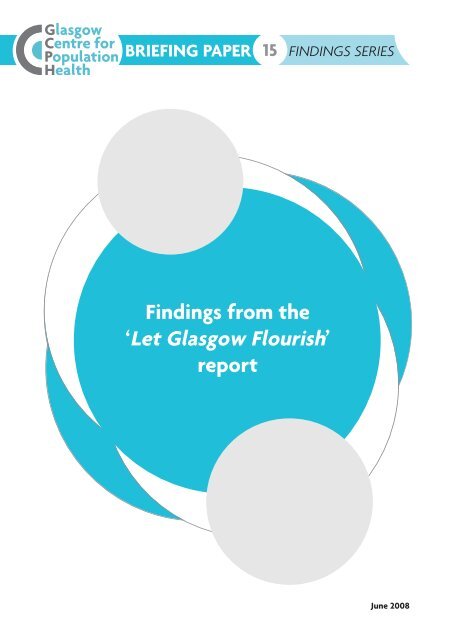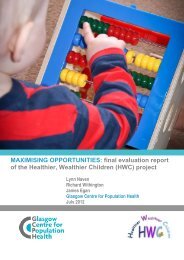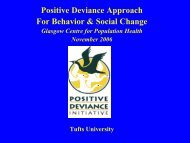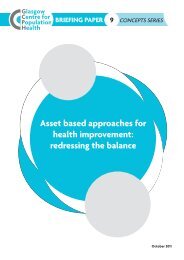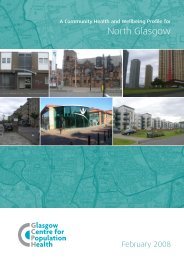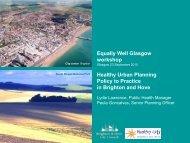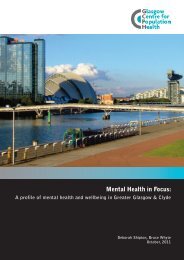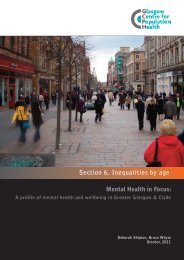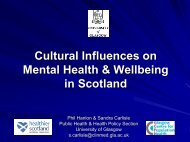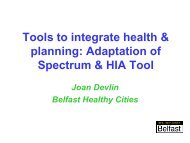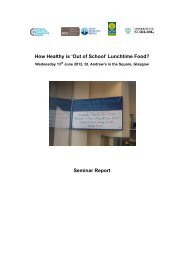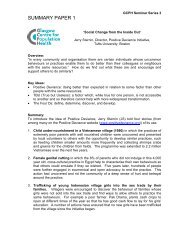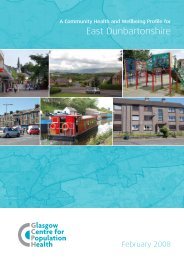BRIEFING PAPER 15 Findings from the 'Let Glasgow Flourish' report ...
BRIEFING PAPER 15 Findings from the 'Let Glasgow Flourish' report ...
BRIEFING PAPER 15 Findings from the 'Let Glasgow Flourish' report ...
Create successful ePaper yourself
Turn your PDF publications into a flip-book with our unique Google optimized e-Paper software.
<strong>BRIEFING</strong> <strong>PAPER</strong> <strong>15</strong><br />
FINDINGS SERIES<br />
<strong>Findings</strong> <strong>from</strong> <strong>the</strong><br />
‘Let <strong>Glasgow</strong> Flourish’<br />
<strong>report</strong><br />
June 2008
FINDINGS SERIES<br />
<strong>15</strong><br />
<strong>BRIEFING</strong> <strong>PAPER</strong><br />
KEY FINDINGS<br />
Let <strong>Glasgow</strong> Flourish 1 is a comprehensive review of health and its determinants in<br />
<strong>Glasgow</strong> and <strong>the</strong> West of Scotland. What emerges <strong>from</strong> <strong>the</strong> very wide range of data that<br />
have been syn<strong>the</strong>sized into <strong>the</strong> <strong>report</strong> is <strong>the</strong> scale and diversity of change experienced in<br />
<strong>Glasgow</strong> over <strong>the</strong> last 20-30 years. As late as <strong>the</strong> 1970s <strong>Glasgow</strong> was still an industrial and<br />
manufacturing city. The economic depression of that period destroyed many of <strong>the</strong>se jobs<br />
and it has taken time for <strong>the</strong> city’s economy to recover. During recovery, <strong>the</strong> social class<br />
and employment profile of <strong>the</strong> city’s population has changed significantly. Economic<br />
regeneration has been accompanied by a physical regeneration, at least for many parts of<br />
<strong>the</strong> city. <strong>Glasgow</strong> is now a predominantly a ‘middle class’ city with a strong emphasis on<br />
service industries.<br />
<strong>Findings</strong> <strong>from</strong> <strong>the</strong> ‘Let <strong>Glasgow</strong> Flourish’ <strong>report</strong><br />
Let <strong>Glasgow</strong> Flourish captures <strong>the</strong> health and social trends that have emerged <strong>from</strong> this<br />
transformation. Some trends have improved (e.g. overall life expectancy and death rates of<br />
major diseases like heart disease and cancer) but o<strong>the</strong>rs are showing deterioration. For<br />
example:<br />
• inequalities between <strong>the</strong> most advantaged and least advantaged areas have resisted<br />
interventions and in some cases become worse;<br />
• high levels of worklessness caused in no small measure by high levels of invalidity;<br />
• rising epidemics of obesity, alcohol related harm, health problems related to drug<br />
addiction, some mental health problems and sexually transmitted infections.<br />
Adverse trends in <strong>the</strong>se areas are not unique to <strong>Glasgow</strong> but <strong>the</strong> city suffers <strong>from</strong> a<br />
particularly virulent manifestation of <strong>the</strong>se problems. The <strong>report</strong> warns that, just as<br />
<strong>Glasgow</strong> stayed committed to industry and manufacturing well past <strong>the</strong> time that o<strong>the</strong>r<br />
cities had diversified <strong>the</strong>ir economies, <strong>the</strong>re is a danger that <strong>Glasgow</strong>'s current<br />
dependency on and investment in a highly consumer orientated economy may make it<br />
vulnerable to oil shocks or o<strong>the</strong>r unforeseen economic or ecological forces.<br />
Debate and fresh thinking are needed to confront both current and emerging social,<br />
economic and health challenges in <strong>the</strong> city and surrounding region.<br />
2
<strong>BRIEFING</strong> <strong>PAPER</strong> <strong>15</strong><br />
FINDINGS SERIES<br />
INTRODUCTION<br />
Let <strong>Glasgow</strong> Flourish was <strong>the</strong> first major <strong>report</strong> to emerge <strong>from</strong> <strong>the</strong> <strong>Glasgow</strong> Centre for<br />
Population Health (GCPH)’s Observatory Function.<br />
The perspective on health underlying <strong>the</strong> <strong>report</strong> can be summarised in one phrase, ‘it all<br />
matters’. What is meant by this is that health in populations emerges <strong>from</strong> a complex<br />
interplay between <strong>the</strong> physical environment, social environment, individual response and<br />
behaviour, genetic endowment and <strong>the</strong> provision of services interacting with economic<br />
and o<strong>the</strong>r influences <strong>from</strong> which <strong>the</strong> health status of a city emerges. These factors<br />
interact and combine over <strong>the</strong> human life-span to create or destroy health. These<br />
influences also give rise to <strong>the</strong> patterns of inequality that are so apparent in <strong>Glasgow</strong>.<br />
Acknowledging this holistic model of health, Let <strong>Glasgow</strong> Flourish was designed to<br />
provide data on a range of health related domains, so that, taken toge<strong>the</strong>r, a<br />
comprehensive picture of health in <strong>the</strong> region could be created. A full description of how<br />
we developed our approach to public health data is provided elsewhere 2 .<br />
AIMS AND PURPOSE<br />
Our purpose in creating this <strong>report</strong> was relatively simple. We aimed to create a detailed<br />
description of health and its determinants in <strong>Glasgow</strong> and <strong>the</strong> West of Scotland. It was<br />
<strong>the</strong>n our intention to use <strong>the</strong> <strong>report</strong> to increase understanding, provoke debate and<br />
stimulate action.<br />
<strong>Findings</strong> <strong>from</strong> <strong>the</strong> ‘Let <strong>Glasgow</strong> Flourish’ <strong>report</strong><br />
The intended audience was broad - ‘anyone in a position to influence health in <strong>Glasgow</strong> and<br />
<strong>the</strong> West of Scotland’ – and for this reason it was our intention to disseminate <strong>the</strong> <strong>report</strong><br />
widely via <strong>the</strong> GCPH web site, through talks, engaging with <strong>the</strong> media and through a ‘civic<br />
conversation’. Our ultimate aim being to move beyond merely describing health in <strong>the</strong><br />
region towards reaching a new consensus about what needs to be done to transform <strong>the</strong><br />
overall health of <strong>Glasgow</strong>’s population and to address <strong>the</strong> profound health inequalities<br />
within <strong>the</strong> city and region.<br />
3
FINDINGS SERIES<br />
<strong>15</strong><br />
<strong>BRIEFING</strong> <strong>PAPER</strong><br />
APPROACH AND METHODS<br />
The <strong>report</strong> was designed to provide a detailed overview of health and its determinants in<br />
<strong>Glasgow</strong> and <strong>the</strong> West of Scotland. Although <strong>the</strong> <strong>report</strong> is an integrated whole, each chapter<br />
explores a specific <strong>the</strong>me and can be read on its own.<br />
Following an introductory chapter, <strong>the</strong> content is as follows:<br />
• Chapter 2 provides a historical perspective on <strong>Glasgow</strong>’s population;<br />
• Chapter 3 looks at issues concerning population and life expectancy;<br />
<strong>Findings</strong> <strong>from</strong> <strong>the</strong> ‘Let <strong>Glasgow</strong> Flourish’ <strong>report</strong><br />
• Chapter 4 considers economic factors;<br />
• Chapter 5 presents data relevant to <strong>the</strong> ‘social environment’ in which people live (and so<br />
includes topics such as education, crime, and social capital);<br />
• Chapter 6 examines <strong>the</strong> physical environment;<br />
• Chapter 7 reviews health related behaviour;<br />
• Chapter 8 includes data related to pregnancy, childbirth and early years;<br />
• Chapter 9 describes <strong>the</strong> health and wellbeing of children and adolescents;<br />
• Chapter 10 looks at indicators of <strong>the</strong> health and function of <strong>the</strong> population;<br />
• Chapter 11 examines <strong>the</strong> topic of illness and disease;<br />
• Chapter 12 looks at past and future trends; and finally<br />
• Chapter 13 provides a summary and discusses possible new approaches.<br />
The information included in each chapter has been drawn <strong>from</strong> a wide range of academic and<br />
research publications, <strong>from</strong> local organisations (eg Social Work departments and Strathclyde<br />
Police) and <strong>from</strong> national sources, such as <strong>the</strong> 2001 Census, <strong>the</strong> General Register Office of<br />
Scotland, ISD Scotland and <strong>the</strong> Scottish Executive (now <strong>the</strong> Scottish Government). The<br />
indicators required were obtained ei<strong>the</strong>r directly <strong>from</strong> an internet site or through specific<br />
requests. Many of <strong>the</strong> health indicators were obtained directly <strong>from</strong> ISD Scotland, while o<strong>the</strong>rs,<br />
for example <strong>the</strong> mortality and life expectancy indicators, were calculated by GCPH. A major<br />
source of material was NHS Health Scotland’s Community Health and Wellbeing Profiles 3 .<br />
It is too early to make a proper evaluation of <strong>the</strong> impact of <strong>the</strong> profiles. However we have<br />
started to ga<strong>the</strong>r feedback <strong>from</strong> key informants, some of which is included below.<br />
4
<strong>BRIEFING</strong> <strong>PAPER</strong> <strong>15</strong><br />
FINDINGS SERIES<br />
FINDINGS<br />
Summarising this <strong>report</strong>, which includes 13 chapters and runs to over 300 pages, is challenging.<br />
Here four main <strong>the</strong>mes are summarised:<br />
• how <strong>Glasgow</strong> has changed as a place, particularly over <strong>the</strong> last 25 years<br />
• <strong>the</strong> health profile of <strong>Glasgow</strong>: what is getting better, what is proving resistant to change and<br />
what is getting worse<br />
• how we make sense of <strong>the</strong>se trends<br />
• future challenges in relation to demography, economic factors, health behaviours and<br />
sustainability<br />
How <strong>Glasgow</strong> has changed as a place<br />
<strong>Glasgow</strong> has undergone a profound transformation in recent times. It is true that all cities have<br />
altered in <strong>the</strong> last 25 years, but <strong>Glasgow</strong> not only typifies <strong>the</strong>se changes, it has experienced <strong>the</strong><br />
most rapid change in Scotland and has been at <strong>the</strong> forefront (in terms of <strong>the</strong> scale of its<br />
transformation) in <strong>the</strong> UK. In addition to <strong>the</strong> obvious physical improvements in <strong>the</strong> city, <strong>the</strong>re has<br />
been a significant amount of social transition. Since <strong>the</strong> 1980s, <strong>the</strong> following social, demographic<br />
and housing trends have been influential:<br />
• Population decline since <strong>the</strong> 1950s - driven particularly by <strong>the</strong> drop in <strong>Glasgow</strong>’s birth rate,<br />
which fell beneath <strong>the</strong> death rate for <strong>the</strong> first time in <strong>the</strong> mid 1970s.<br />
• Localised population loss due to out-migration has been particularly evident in <strong>the</strong> peripheral<br />
estates and in <strong>the</strong> most deprived parts of <strong>the</strong> city.<br />
• An increase in <strong>the</strong> number and proportion of residents aged between 25 and 44, even with<br />
overall population levels in decline.<br />
• Increasing numbers of households overall and, within this, a growth in single adult households,<br />
a drop in two parent family households and a rise in lone parent households.<br />
• Growth of a service sector based economy – comprising finance, business, <strong>the</strong> public sector,<br />
retail and hospitality and compensating to a degree for <strong>the</strong> collapse of manufacturing industry.<br />
• Doubling of jobs in occupations considered as middle class employment, reflecting <strong>the</strong> growth<br />
in <strong>the</strong> service sector.<br />
• Increasing involvement of women in employment and <strong>the</strong> growth of part-time work.<br />
• Increased general levels of prosperity and a generalised reduction in indices of overall<br />
deprivation - as measured, for instance, by increased car ownership and reduced levels<br />
overcrowding.<br />
• Rising income levels for those in employment; significant falls in unemployment rates.<br />
• Transformations to <strong>the</strong> quality and condition of housing in <strong>the</strong> city, and doubling of owneroccupation,<br />
with growth both in <strong>the</strong> city centre and in <strong>the</strong> peripheral estates.<br />
<strong>Findings</strong> <strong>from</strong> <strong>the</strong> ‘Let <strong>Glasgow</strong> Flourish’ <strong>report</strong><br />
In short, much of <strong>Glasgow</strong> has become a more affluent and ‘middle class’ city with a profile that<br />
is currently similar to most UK cities. Yet, <strong>Glasgow</strong>’s overall health status does not fully reflect <strong>the</strong><br />
changes described above. There is a ‘<strong>Glasgow</strong> effect’ 4,i – that is, an excess of mortality beyond<br />
that which can be explained by current indexes of deprivation. The result is that <strong>Glasgow</strong>’s health<br />
status remains worse than that of comparable English cities like Liverpool.<br />
i<br />
The supplied reference relates to <strong>the</strong> existence of a ‘Scottish effect’. However, that research has shown that <strong>the</strong> areas<br />
most affected are in <strong>Glasgow</strong> and <strong>the</strong> West of Scotland.<br />
5
FINDINGS SERIES<br />
<strong>15</strong><br />
<strong>BRIEFING</strong> <strong>PAPER</strong><br />
Thus, while <strong>the</strong>re have been many positive changes in <strong>Glasgow</strong> over <strong>the</strong> last twenty years, <strong>the</strong>re<br />
remain notable causes for concern.<br />
Socio-economic, health and environmental differences between affluent and deprived<br />
communities are still clearly evident. The income gap between <strong>the</strong> well-paid and those on <strong>the</strong><br />
lowest incomes has widened. Official unemployment levels have reduced but increases in<br />
economic activity have not been realised because a significant proportion (<strong>15</strong>%+) of <strong>the</strong> working<br />
age population is recorded as being too ill or disabled to work. The proportion of families in<br />
<strong>Glasgow</strong> dependent on income related benefits is relatively high and has been so for many years,<br />
and a third of children live in households where nei<strong>the</strong>r parent is in work. Although overall<br />
crime levels have reduced <strong>the</strong>re have been worrying rises in violent crime, drug related crime and<br />
vandalism.<br />
<strong>Findings</strong> <strong>from</strong> <strong>the</strong> ‘Let <strong>Glasgow</strong> Flourish’ <strong>report</strong><br />
Changes in <strong>Glasgow</strong>’s health profile<br />
What is getting better<br />
An analysis of what is getting better in <strong>Glasgow</strong> is illuminating and challenges a number of<br />
stereotypes. Life expectancy continues to increase overall and <strong>the</strong>re are encouraging trends in<br />
smoking, unemployment, teenage pregnancies, some crimes, and some specific causes of death<br />
(eg heart disease, stroke, some cancers, accidents, infant mortality).<br />
Two of <strong>the</strong>se trends are worth particular comment. First, smoking has shown a steady decline for<br />
two decades. This is part of a national trend but reflects a multiplicity of national and local<br />
interventions (tax, health warnings on packets, workplace smoking policies, smoking cessation<br />
initiatives, advertising campaigns, schools programmes and much more) that, over time, have<br />
made a difference. Second, deaths <strong>from</strong> heart disease continue to show a marked decline to <strong>the</strong><br />
extent that, although it was true that at one time <strong>Glasgow</strong> was <strong>the</strong> ‘coronary capital of <strong>the</strong><br />
world’ this is no longer <strong>the</strong> case.<br />
What is proving resistant to change<br />
The answer to this question is: some aspects of health related behaviour (eg <strong>the</strong> dental health of<br />
children and breastfeeding) and many of <strong>the</strong> circumstances in which people live (eg indices of<br />
poverty and low income), and indices that reflect disability or chronic disease (eg adults unable<br />
to work for reasons of health and ‘healthy life expectancy’).<br />
What is getting worse<br />
Inequalities in health are widening, and we know <strong>from</strong> numerous studies – many of <strong>the</strong>m recent<br />
– that <strong>the</strong> health of <strong>Glasgow</strong>'s population, as measured by a variety of indicators, is still amongst<br />
<strong>the</strong> worst in Scotland, and indeed in <strong>the</strong> UK, and that position does not appear to be<br />
improving 5,6 . There is also evidence that <strong>Glasgow</strong>'s health position in comparison to o<strong>the</strong>r parts<br />
of Scotland (for example, as measured by rates in all-cause mortality) has worsened relatively<br />
over <strong>the</strong> last 25 years.<br />
6<br />
However, some of <strong>the</strong> more specific problems that are worsening are interesting because <strong>the</strong>y,<br />
arguably, have a relationship to each o<strong>the</strong>r. Obesity is showing a worrying rise. We are part of a<br />
global epidemic of obesity but our levels are among <strong>the</strong> highest in <strong>the</strong> world and show no sign<br />
of slowing. More obesity has already brought rising rates of diabetes and might put into reverse
<strong>BRIEFING</strong> <strong>PAPER</strong> <strong>15</strong><br />
FINDINGS SERIES<br />
our improving heart disease trends. Alcohol related harm also shows a dramatic increase and<br />
concern has been raised that we are ‘in denial’ about <strong>the</strong> size and nature of this problem. The<br />
size of our ‘drugs’ problem is harder to measure but data in this <strong>report</strong> suggest that, at best, it is<br />
not improving. Notifications of sexually transmitted infections are rising, some aspects of mental<br />
health seem to be worsening and inequalities between <strong>the</strong> most and least deprived communities<br />
are increasing ii . It is also notable that traffic volumes continue to rise and that vandalism, fireraising<br />
and violent crime are rising.<br />
How do we make sense of <strong>the</strong>se trends<br />
The historian, Professor Tom Devine, in a lecture hosted by <strong>the</strong> <strong>Glasgow</strong> Centre for Population<br />
Health iii argued two main points. First, that Scotland has, historically, experienced a series of<br />
social and economic changes more profoundly than any o<strong>the</strong>r part of <strong>the</strong> industrialised world<br />
and, second, <strong>the</strong> past twenty years have seen a marked improvement. His arguments refer to <strong>the</strong><br />
whole of Scotland but <strong>Glasgow</strong>’s experience exemplifies his analysis more than any o<strong>the</strong>r part of<br />
country.<br />
Devine’s argument is that when <strong>the</strong> industrial revolution started, Scotland experienced a more<br />
rapid and profound industrialisation, with higher migration <strong>from</strong> <strong>the</strong> land and a greater intensity<br />
of urbanisation, than most regions of Europe. Next, Scotland experienced <strong>the</strong> highest per capita<br />
death rate on <strong>the</strong> battlefields of World War I and a deep economic slump during <strong>the</strong> great<br />
depression. Scotland, and in particular West Central Scotland, continued to rely on heavy<br />
industry much longer than most o<strong>the</strong>r European regions. Consequently, when <strong>the</strong> collapse of<br />
heavy industry occurred in <strong>the</strong> 1960s, 70s and 80s, <strong>the</strong> effect was more profound. This analysis<br />
provides a convincing narrative to explain <strong>the</strong> relatively poor heath of <strong>Glasgow</strong> around <strong>the</strong> time<br />
of <strong>the</strong> 1981 census. Unlike cities such as Birmingham, London and Manchester, <strong>Glasgow</strong><br />
maintained its dependence on heavy industry (despite policy initiatives to diversify into light<br />
industry) right up to <strong>the</strong> early 1970s. Therefore, when <strong>the</strong> ‘shock’ came in <strong>the</strong> form of <strong>the</strong> OPEC<br />
oil embargo and <strong>the</strong> three day week, followed by an economic slump, <strong>Glasgow</strong> suffered greatly<br />
<strong>from</strong> de-industrialisation, and unemployment <strong>the</strong>n decimated its traditional working class<br />
communities.<br />
<strong>Findings</strong> <strong>from</strong> <strong>the</strong> ‘Let <strong>Glasgow</strong> Flourish’ <strong>report</strong><br />
The causes of inequalities in health at that time were clear. They resulted <strong>from</strong> income<br />
inequalities and <strong>the</strong> poorer life circumstances of people in lower paid employment and<br />
unemployment. However, in <strong>the</strong> past 20-25 years (since <strong>the</strong> 1981 census) <strong>Glasgow</strong> has experienced<br />
profound changes that have seen a significant improvement in, for example, housing stock,<br />
median wages, levels of employment, nature of employment, social class composition of <strong>the</strong><br />
population and some manifestations of social mobility. We know, of course, that <strong>the</strong><br />
polarisation between <strong>the</strong> most affluent and least affluent communities has become worse -<br />
indeed <strong>the</strong>re is evidence of significant sections of <strong>the</strong> population being left behind as o<strong>the</strong>rs<br />
prosper fur<strong>the</strong>r. However, <strong>the</strong> analysis is not a simple one because <strong>the</strong> sizes of <strong>Glasgow</strong>’s poorest<br />
communities have also decreased significantly since 1981.<br />
ii<br />
Inequalities in life expectancy between <strong>the</strong> most affluent and least affluent communities have increased although <strong>the</strong><br />
populations of <strong>the</strong>se areas have changed over time and more sophisticated analysis is required to make judgements<br />
about <strong>the</strong> overall changes in inequalities in <strong>the</strong> whole population.<br />
iii<br />
Lecture on 6th December 2005 - available at www.gcph.co.uk/seminar2.htm.<br />
7
FINDINGS SERIES<br />
<strong>15</strong><br />
<strong>BRIEFING</strong> <strong>PAPER</strong><br />
The old pathologies, arising <strong>from</strong> socio-economic inequalities of an industrial age, are now<br />
overlaid with a new set of problems that reflect <strong>the</strong> stresses, speed and levels of consumption of<br />
our modern society – obesity, alcohol related harm, mental health problems, traffic congestion<br />
and so on. So, despite our rising prosperity, economic gains remain unequally distributed and,<br />
while our new ‘epidemics’ affect <strong>the</strong> whole population, those who live in <strong>the</strong> least advantaged<br />
areas are suffering most.<br />
<strong>Findings</strong> <strong>from</strong> <strong>the</strong> ‘Let <strong>Glasgow</strong> Flourish’ <strong>report</strong><br />
More recent research comparing mortality trends over <strong>the</strong> last 20 to 25 years among a range of<br />
European regions 7 has shown that mortality in Scotland, and especially <strong>the</strong> West of Scotland, is<br />
particularly high and rates of improvement are relatively slow compared to o<strong>the</strong>r areas in <strong>the</strong> UK<br />
and Europe that have also experienced industrial decline. This finding is complicated by <strong>the</strong> fact<br />
that <strong>the</strong> Scottish areas appear to compare relatively favourably with o<strong>the</strong>r regions in terms of<br />
socio-economic factors such as wealth, unemployment and educational attainment.<br />
Future challenges<br />
Let <strong>Glasgow</strong> Flourish points to a range of major challenges that <strong>Glasgow</strong> is likely to face, or is<br />
already facing. These include population change, economic factors, adverse health behaviours<br />
and sustainability.<br />
As mentioned above, a number of important population and household trends have been<br />
identified. Demographic changes have already driven service changes. For example, <strong>the</strong> drop in<br />
<strong>the</strong> school age population has led to widespread amalgamations of schools across <strong>Glasgow</strong>.<br />
Without rises in <strong>the</strong> birth rate and/or inward migration, <strong>Glasgow</strong>’s population is likely to drop<br />
fur<strong>the</strong>r. In contrast to <strong>the</strong> population trends, <strong>the</strong> number of households is predicted to rise<br />
consistently over <strong>the</strong> next 20 years<br />
It is in <strong>the</strong> working age population that <strong>the</strong> health of <strong>Glasgow</strong> as a city and <strong>the</strong> overall health of<br />
its population will be determined. <strong>Glasgow</strong>’s current low dependency ratio – which is predicted<br />
to remain low until 2024 - gives <strong>the</strong> city, <strong>the</strong>oretically, a healthy economic employment base.<br />
However, this does not take account of people of working age not working or unable to work due<br />
to incapacity, of which <strong>Glasgow</strong> has a high proportion.<br />
It is also notable that <strong>Glasgow</strong>’s ethnic minority population has risen in recent years (to 5.5% in<br />
2001) and looks set to increase fur<strong>the</strong>r, particularly taking into account <strong>the</strong> recent rise in <strong>the</strong><br />
asylum seeker and refugee population and <strong>the</strong> influx of economic migrants <strong>from</strong> <strong>the</strong> A8 countries<br />
of Europe.<br />
In terms of work and <strong>the</strong> economy major changes have also occurred. The gender make-up of<br />
<strong>the</strong> work force has shifted massively, <strong>the</strong> service sector has grown to become <strong>the</strong> most important<br />
sector of <strong>Glasgow</strong>’s economy, <strong>Glasgow</strong> has become more middle class, income for those in work<br />
has risen, greater numbers of households have access to a car, many more people own <strong>the</strong>ir own<br />
home and house prices have risen hugely in <strong>the</strong> last ten years.<br />
8<br />
Participation in higher education, a marker for future employability in <strong>the</strong> knowledge economy,<br />
has risen, but only modestly in recent years. The proportions of young people <strong>from</strong> deprived<br />
areas reaching university has increased, but <strong>the</strong>re has not been an appreciable narrowing of <strong>the</strong><br />
gap in participation rates between affluent and deprived communities.
<strong>BRIEFING</strong> <strong>PAPER</strong> <strong>15</strong><br />
FINDINGS SERIES<br />
Turning to health, despite <strong>Glasgow</strong>’s current poor position relative to o<strong>the</strong>r parts of<br />
Scotland and <strong>the</strong> UK, <strong>the</strong>re have been successes. Infant mortality has reduced dramatically –<br />
perhaps to a level where fur<strong>the</strong>r significant reductions may be much harder to achieve – and<br />
overall mortality, and that related to specific chronic diseases (heart disease, stroke and<br />
cancer), has fallen. However <strong>the</strong> issue for <strong>Glasgow</strong> is that greater reductions have been<br />
achieved elsewhere and so <strong>Glasgow</strong>’s health has become relatively worse in comparison to<br />
<strong>the</strong> rest of Scotland and o<strong>the</strong>r UK cities. Estimates of life expectancy suggest that<br />
Glaswegians not only live shorter lives, but also succumb to disease and illness earlier in life.<br />
Future trends are difficult to predict. However, a simple linear extrapolation of current life<br />
expectancy trends in <strong>the</strong> West of Scotland suggests that, while life expectancy for both men<br />
and women will increase, <strong>the</strong> rises will be greatest in <strong>the</strong> most affluent areas with more<br />
modest improvements in <strong>the</strong> most deprived areas, leading to a fur<strong>the</strong>r widening in <strong>the</strong> life<br />
expectancy gap between such communities.<br />
Trends in health behaviour will have an impact on future disease and mortality levels.<br />
Smoking levels, while still high, have reduced in recent years and seem likely to drop fur<strong>the</strong>r.<br />
However, o<strong>the</strong>r behavioural trends are less promising. Obesity levels have risen to <strong>the</strong> extent<br />
that in Greater <strong>Glasgow</strong> a fifth of males and almost a quarter of females are now estimated<br />
to be obese, with well over half classified as overweight.<br />
Ano<strong>the</strong>r major concern relates to alcohol. There are estimated to be more than 13,500<br />
‘problem alcohol users’ resident within <strong>Glasgow</strong> City, and since <strong>the</strong> beginning of <strong>the</strong> 1990s,<br />
<strong>the</strong>re has been a striking increase in numbers of alcohol related deaths and hospitalisations<br />
within both Scotland and <strong>the</strong> Greater <strong>Glasgow</strong> area. Simple projections of alcohol related<br />
deaths based on recent trends suggest that <strong>the</strong> number of alcohol related deaths in Greater<br />
<strong>Glasgow</strong> could double in <strong>the</strong> next twenty years.<br />
<strong>Findings</strong> <strong>from</strong> <strong>the</strong> ‘Let <strong>Glasgow</strong> Flourish’ <strong>report</strong><br />
The impact of illicit drugs should not be overlooked ei<strong>the</strong>r. Between 1996 and 2004, drug<br />
related deaths in Greater <strong>Glasgow</strong> rose by a third. There are estimated to be around 25,000<br />
problem drug users in <strong>the</strong> West of Scotland, of whom more than 11,000 live in <strong>Glasgow</strong>.<br />
Two o<strong>the</strong>r sets of trends are also worthy of consideration. The physical environment<br />
chapter showed that despite improvements in overall house condition and dramatic<br />
decreases in levels of overcrowding, housing-related problems persist for considerable<br />
numbers of residents of Greater <strong>Glasgow</strong> and <strong>the</strong> West of Scotland. Fur<strong>the</strong>rmore, <strong>the</strong><br />
arguably unsustainable predicted rise in traffic volume clearly merits consideration in any<br />
future plan for <strong>the</strong> city. This is particularly pertinent given <strong>the</strong> rise in <strong>the</strong> price of oil as we<br />
move towards a ‘peak oil’ situation - where global oil production has reached a peak and<br />
half of <strong>the</strong> oil reserves have been consumed.<br />
Finally, children are <strong>the</strong> future of any city. Thus, <strong>the</strong> relatively high number of children being<br />
brought up in potentially problematic environments (eg as children of substance misusers, in<br />
care, in workless households) is a concern, as are <strong>the</strong> worrying levels of childhood obesity,<br />
poor dental health and potentially harmful behaviours (smoking, drinking, drug taking)<br />
presented in <strong>the</strong> <strong>report</strong>.<br />
9
FINDINGS SERIES<br />
<strong>15</strong><br />
<strong>BRIEFING</strong> <strong>PAPER</strong><br />
CONCLUSIONS AND IMPLICATIONS<br />
While trends in some of <strong>Glasgow</strong>’s health problems are moving in a positive direction, for<br />
example reductions in heart disease and smoking, o<strong>the</strong>r new issues have emerged,<br />
particularly in relation to alcohol, drugs and weight gain associated with our post-industrial<br />
consumerist environment. Deprivation remains and is particularly concentrated in <strong>Glasgow</strong><br />
and its surrounding post-industrialised towns. Deprivation on its own does not explain all<br />
of <strong>Glasgow</strong>’s ill-health, but it does strongly influence <strong>Glasgow</strong>’s continued poor health.<br />
<strong>Findings</strong> <strong>from</strong> <strong>the</strong> ‘Let <strong>Glasgow</strong> Flourish’ <strong>report</strong><br />
The health of <strong>Glasgow</strong>’s economy is vital to <strong>the</strong> health of <strong>Glasgow</strong>. Efforts to raise income<br />
levels among those on <strong>the</strong> lowest incomes, to reduce <strong>the</strong> city’s ‘workless’ population and<br />
to improve skills and education levels could be protective for health, and help prevent<br />
fur<strong>the</strong>r widening of health inequalities. Addressing and reducing health-damaging<br />
behaviours also continue to present a major challenge.<br />
When Let <strong>Glasgow</strong> Flourish was published we proposed that a ‘conversation’ was needed<br />
to debate <strong>the</strong> issues brought up in <strong>the</strong> <strong>report</strong> – a civic conversation. This has happened<br />
through <strong>the</strong> series of civic conversations organised by Andrew Lyon for GCPH; through NHS<br />
Greater <strong>Glasgow</strong> and Clyde’s recent public health <strong>report</strong> 8 , which was based around <strong>the</strong> main<br />
<strong>the</strong>mes of Let <strong>Glasgow</strong> Flourish, and its dissemination; and also through <strong>the</strong> Centre’s<br />
seminar series and Healthier Future Forums. However, fresh thinking and action are still<br />
needed to confront <strong>the</strong> intractable social, economic and health problems of <strong>the</strong> region and<br />
to be prepared for new challenges as <strong>the</strong>y arise. The <strong>Glasgow</strong> Centre for Population Health<br />
will contribute to those processes through its range of functions, and its role in<br />
emphasising <strong>the</strong> need and opportunities for fresh approaches and ambitious goals for <strong>the</strong><br />
city’s health.<br />
10
<strong>BRIEFING</strong> <strong>PAPER</strong> <strong>15</strong><br />
FINDINGS SERIES<br />
REFERENCES<br />
1. Hanlon P, Walsh D and Whyte B. Let <strong>Glasgow</strong> Flourish. <strong>Glasgow</strong> Centre for Population<br />
Health, 2006 www.gcph.co.uk/content/view/17/34/<br />
2. Hanlon P., Walsh D., and Whyte B. Meeting <strong>the</strong> information needs of <strong>the</strong> ‘Health for<br />
all’ challenge – lessons <strong>from</strong> Scotland. Public Health, Vol 119, 12, pp 1088-1096, 2005.<br />
3. NHS Health Scotland. Community Health and Wellbeing Profiles, 2004<br />
www.scotpho.org.uk/communityprofiles<br />
4. Hanlon P., Lawder R.S., Buchanan D. et al. Why is mortality higher in Scotland than in<br />
England and Wales Decreasing influence of socioeconomic deprivation between 1981<br />
and 2001 supports <strong>the</strong> existence of a ‘Scottish Effect’. Journal of Public Health, Vol. 27,<br />
No. 2, pp. 199-204. 2005.<br />
5. Palmer G., Carr J., and Kenway P. Monitoring poverty and social exclusion in Scotland<br />
2004. Joseph Rowntree Foundation, 2004.<br />
6. Shaw M., Dorling D., Gordon D., & Davey Smith, G. The Widening Gap: health<br />
inequalities and policy in Britain, 2nd edition, The Policy Press, Bristol, 1999.<br />
7. Walsh D., Taulbut M. and Hanlon P. The Aftershock of Deindustrialisation. Trends in<br />
mortality in Scotland and o<strong>the</strong>r parts of post-industrial Europe. <strong>Glasgow</strong> Centre for<br />
Population Health, 2008. http://www.gcph.co.uk/content/view/144/68/<br />
<strong>Findings</strong> <strong>from</strong> <strong>the</strong> ‘Let <strong>Glasgow</strong> Flourish’ <strong>report</strong><br />
8. NHS Greater <strong>Glasgow</strong> and Clyde. A Call to debate, a Call to action: a <strong>report</strong> on <strong>the</strong><br />
health of <strong>the</strong> population of NHS Greater <strong>Glasgow</strong> and Clyde 2007-2008. <strong>Glasgow</strong>:<br />
2007 http://www.nhsgg.org.uk/content/default.asppage=s1009_3<br />
ACKNOWLEDGEMENTS<br />
There were many people who helped provide information for <strong>the</strong> Let <strong>Glasgow</strong> Flourish<br />
<strong>report</strong> and we reiterate o<strong>the</strong>r thanks to all those many contributors. Please refer <strong>the</strong><br />
<strong>report</strong> itself for detailed acknowledgements.<br />
11
FINDINGS SERIES<br />
<strong>15</strong><br />
<strong>BRIEFING</strong> <strong>PAPER</strong><br />
CONTACTS<br />
Bruce Whyte<br />
Public Health Programme Manager<br />
<strong>Glasgow</strong> Centre for Population Health<br />
Level 6, 39 St Vincent Place<br />
<strong>Glasgow</strong>, G1 2ER<br />
<strong>Findings</strong> <strong>from</strong> <strong>the</strong> ‘Let <strong>Glasgow</strong> Flourish’ <strong>report</strong><br />
Tel: 0141 221 9439<br />
Email: bruce.whyte@drs.glasgow.gov.uk<br />
Web: www.gcph.co.uk<br />
The ‘Let <strong>Glasgow</strong> Flourish’ <strong>report</strong> can be accessed at:<br />
www.gcph.co.uk/content/view/17/34/<br />
12


